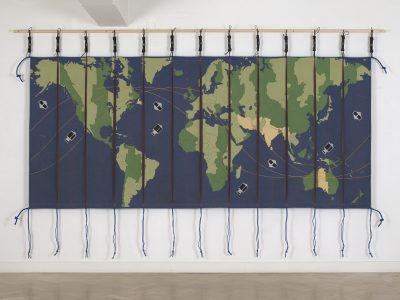Borrowing from the Collection
We are always always keen to explore ways to offer public access to the Government Art Collection. We encourage loans from our Collection and welcome any questions you might have.
-
Who does the Collection lend to?
- Public museums and galleries, libraries, archives, educational institutions and charitable bodies
- Community organisations
- Institutions that are accessible to the general public and offer suitable facilities and appropriate display conditions
-
How do I request to borrow from the Collection?
Requests to borrow objects from the Collection should be addressed to the Government Art Collection Director Eliza Gluckman and emailed to gac@dcms.gov.uk. In the request, please include the following:
- The Government Art Collection object number (GAC number) where possible. You can search for the object on our website and find this under the ‘Details’ section
- The title and dates of the exhibition
- A clear rationale for the inclusion of the objects in the exhibition, display or project
- Information about the exhibition, other objects being displayed and how the object fits into the exhibition
- Information on the venue, or all venues for a touring exhibition, preferably using UK Registrars Group (UKRG) facilities reports and security supplement
- The venue address and names and contact details of key staff involved
We request at least nine months’ notice for UK loans and twelve months’ for loans to international venues, although we will consider all loan requests. We generally consider loans for exhibitions or displays with a duration of at least three months and encourage informal discussions before a formal request is made.
Loans may be made on a short-term basis (up to one year) to one or more venues, or on a long-term basis. For long-term loans, the maximum first loan period is three years, after which the loan is reviewed and may either be returned or renewed. The Government Art Collection does not agree to indefinite or permanent long loans.
-
What happens after I request an item?
We will acknowledge your request within two weeks, and request any additional information needed.
All loan requests are considered at our fortnightly Loan Review meetings following a full assessment. The loan assessment process is coordinated by our Registrars and we endeavour to communicate a decision within six weeks.
Key considerations:
- Relevance of the requested object(s) to the exhibition or display
- Availability of the object(s)
- Suitability of the object(s) for travel and display
- Administrative and technical work involved, in the context of the Collection’s existing programme of activity
We welcome considerations of the environmental impact of a request.
We will consider access, diversity and inclusion when assessing loan requests. We aim to take a respectful and inclusive approach to our collection’s display and interpretation, and encourage our borrowers to do the same.
We will issue a loan agreement for all approved loans, which will outline the purpose and terms of the loan. Every borrower will sign this agreement before the loan commences.
-
Why would a loan request be refused?
We refuse loans from time to time. This may be for any of the following reasons:
- When the requested object requires conservation treatment, with insufficient time or funds available to carry out such work
- There is insufficient time to consider and prepare the loan
- If the requested object is fragile, or unstable or at excessive risk of damage from handling or transit
- If the requested object is currently on display and a suitable replacement may not be easily found
- A compelling case for the loan has not been made by the borrower
- The object will not be accessible to the public
- If lending the requested object would result in a significant environmental impact
- If the requested object has already been committed to another project
- When suitable environmental and/or security requirements cannot be met
We always aim to work with potential borrowers to overcome environmental and display issues and encourage early discussion around this.
Where an object is already scheduled for display or loan, we will endeavour to offer an alternative if available.
The Government Art Collection will not lend to any exhibition or display that appears to include illicitly traded items and specifically contravenes the UNESCO Convention on the Means of Prohibiting And Preventing the Illicit, Export and Transfer of Ownership of Cultural Property, 1970.
-
Are there any costs involved?
We do not have a standard borrowing fee for loans from the Collection.
We try to keep costs to a minimum, however on some occasions we may ask a borrower to contribute towards the costs associated with the preparation of the requested objects (e.g. framing and glazing), with the transfer of the requested object, including if this is on display overseas, or with replacing an object on display.
Other costs such as crating, packing, insurance and transport of the artworks to and from the Government Art Collection will need to be met by the borrower.
The borrower will need to insure all items, based on valuations provided by us, on an ‘agreed value’, ‘all-risks’, ‘nail-to-nail’ basis. A copy of the insurance policy must be sent well in advance of the loan date and a certificate of insurance received prior to the items being dispatched.
The Government Art Collection will accept the UK Government Indemnity Scheme in lieu of commercial insurance, and may also be able to accept indemnities offered by other countries, provided a copy of the indemnity is provided well in advance for us to examine the terms.
-
Loans Policy and Conditions
For more information please see our Loans Policy and Conditions.
More about the Collection
Where can I see the Collection?
Find out where you can see the Government Art Collection, through loans to exhibitions and collections across the UK.
What is the Government Art Collection?
Why does the Government have an art collection? What does it collect? Why is the Collection spread across the world?
Explore the Collection
There are so many ways to discover this unusual collection. Search for an artist, type in a capital city or be surprised by the loudest artwork is in the Government Art Collection!


